Learning how to format a book properly is perhaps the most under-appreciated skill that authors can learn.
And thankfully, book formatting does not need to be hard.
There are a number of tools and tips that will take you most of the way there, and while some of the tools may have an upfront cost, they will do two things:
- Save you time and money in the long run
- Make your books more attractive, so your finished book is more likely to sell, or your manuscript more likely to find a buyer
Let’s find out how.
What is Book Formatting?
Your book format is how your book is displayed in print or in an eBook. It’s the visual aspect of the manuscript, including elements like margins, fonts, word sizes, page numbers, line spacing, paragraph breaks, etc.
In other words, formatting is the look of the book as it appears on the pages.
Book Formatting vs Manuscript Formatting
Formatting a manuscript means preparing the document in an accepted format for literary agents or book editors. Formatting guidelines can vary from one publisher to another, but generally include:
- A standard font and size
- Uniform margins
- Left-hand alignment (not justified)
- Page size
- Scene breaks
Formatting a book is the process of preparing the actual files in the final version of the book. In addition to the above, it can also include:
- Gutter considerations
- Chapter headers
- Front and back matter
- Trim sizes
Additionally, the book’s formatting can differ depending on the medium or vendor you’re dealing with.
Why Formatting Your Book or Manuscript is so Important
Imagine that you buy a book, you open it up, and there are no page numbers, no page headings, the space between the lines is too large, and it simply looks like a high school English assignment.
See why this is a problem? Would you be likely to recommend this book to a friend?
Proper book formatting helps avoid this problem. If you can have a beautifully formatted book or eBook, your customers are more likely to buy it, and more likely to enjoy their reading experience.
In short, you’ll sell more books.
7 Tools for Formatting Your Book
Proper formatting begins with having the right tools.
Below, I’ve put together a list of 7 of the best book formatting tools that will give you the best value for your money.
Now, some of these tools are free, and others cost money. So, be sure to review each one carefully and see which tool satisfies your unique needs.
Let’s take a closer look at each!
1. Microsoft Word
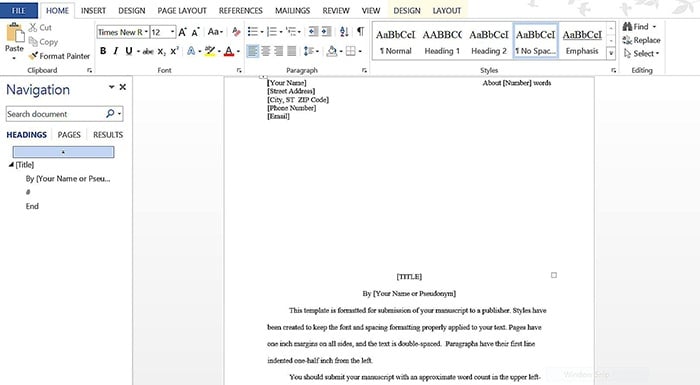
For most writers, Microsoft Word is a platform they probably already have. And as a word processor, it’s one of the best.
Who is it good for? Microsoft Word is best for the writer who’s strapped for cash and already has a solid understanding of the program. While Word isn’t the simplest or best-looking formatting option on this list, it’s still a powerful tool if you know how to use it right.
2. Atticus
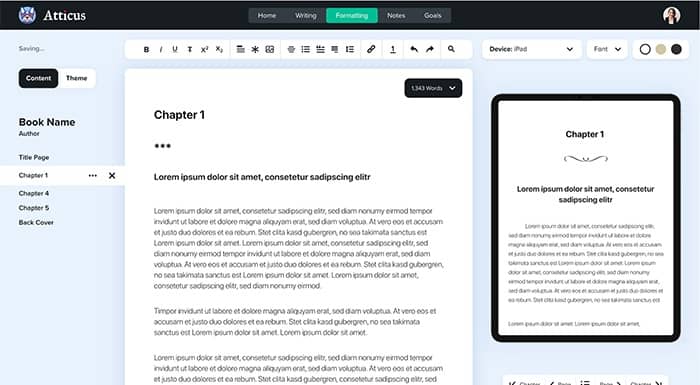
A newcomer to the book formatting world, Atticus is one of the few formatting tools available on most platforms (Mac and PC included). It’s also sold at one of the best prices, $149 (USD). Along with a simple and intuitive interface, Atticus includes cloud capabilities, allowing you to work on your manuscript anytime, anywhere.
Who is it good for? Atticus is best for authors who want a relatively inexpensive solution to create quality manuscripts. It’s great for cutting back on all the complicated steps of using a program like Word.
3. Vellum
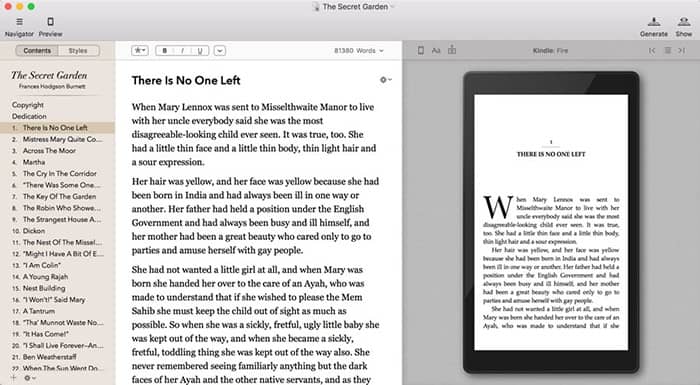
For years, Vellum has been the leader in the book formatting industry. Though expensive, Vellum helps create beautiful-looking books in a snap.
Who is it good for? While Vellum is a viable option, it’s only available for Mac users and will cost you upwards of $199.99 USD ($249.99 if you want to format printed books). That said, the gorgeous end-result of your books speak for themselves.
4. Scrivener
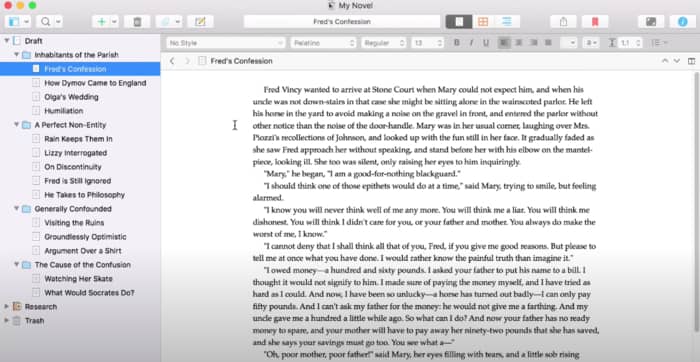
If you’re a writer, then you’ve probably heard of Scrivener. The tool has long been the end-all, be-all of word processors for books. Though primarily engineered as a word processor, it can also format your manuscript for publication.
Who is it good for? Scrivener, like Word, is best for authors that already have an advanced understanding of the platform. Formatting in Scrivener is possible, but there is a learning curve, and most find it a difficult tool to navigate.
5. Adobe InDesign

Speaking of advanced software, Adobe Indesign is probably the most advanced of the bunch. You can format pretty much any type of book with Indesign, but most authors feel the abundance of features overkill for their needs.
Who is it good for? Adobe Indesign is best for authors whose books have special formatting needs — like a children’s book or art book — where the book layout is unique.
6. Kindle Create
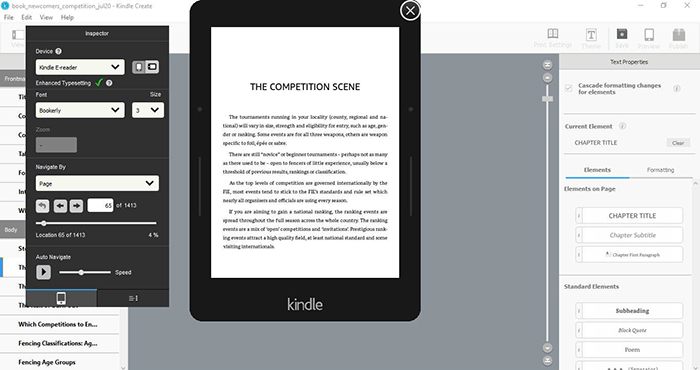
Of the free options on this list, Kindle Create is the best formatting tool. It’s a program created by Amazon specifically for self-published authors to format their books for Kindle Direct Publishing (KDP). That means you’re guaranteed that the eBook files will function properly on Kindle devices.
Who is it good for? Kindle Create is the best solution for authors who have little to spend on a program like Atticus or Vellum. However, it’s a little clunky if you need to add elements like tables, images, footnotes, etc.
7. Hire a Professional

If none of the above work for you, hiring a professional on a platform like Upwork or Fiverr may be a good solution. This process is more expensive, but can often lead to high-quality results with less time commitment.
Who is it good for? Consider using a freelance formatter if you don’t want to learn how to format a book on your own, and are willing to pay the extra cost. If you don’t plan now writing many books, this may be an attractive option.
5 Tools for Manuscript Formatting
Up next we’ll review 5 of the best tools for manuscript formatting.
Not only will these tools save you time, but you’ll also save yourself the embarrassment of having your manuscript rejected because of poor formatting.
Print or eBook formatting is a much different process than manuscript formatting:
- Book formatting is meant to be delivered directly to the reader.
- Manuscript formatting helps prepare your book for literary agents or editors, as per their submission guidelines
So, if you’re preparing a manuscript, you’ll need a solid formatting tool to help you meet these guidelines.
Let’s explore the top 5 manuscript formatting tools.
1. Google Docs
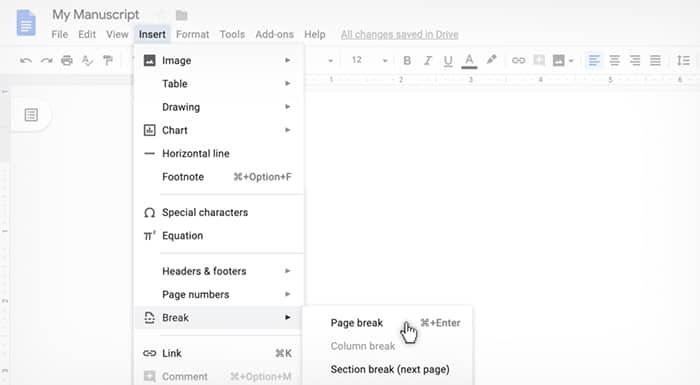
Many authors choose to write in Google Docs these days because of its cloud capabilities and similarity to MS Word. If you’re formatting a manuscript, Google Docs is a fine way to do it.
Who is it good for? Google Docs is great for authors who want to back up all their work to the cloud, and want a simple, free, and easy process to format a manuscript.
2. Microsoft Word (Again)
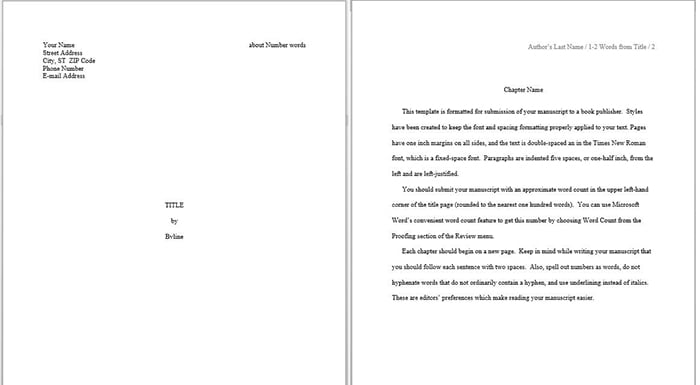
We already mentioned Microsoft Word for book formatting, but it’s an even better program for manuscript formatting. The many features allow you to easily set the page margins, line height, page breaks, and more.
Who is it good for? Microsoft Word is the best software for creating well-formatted manuscripts. If you have access to MS Word, it should be your go-to choice, unless you have some unique needs that Word doesn’t handle.
3. Novlr
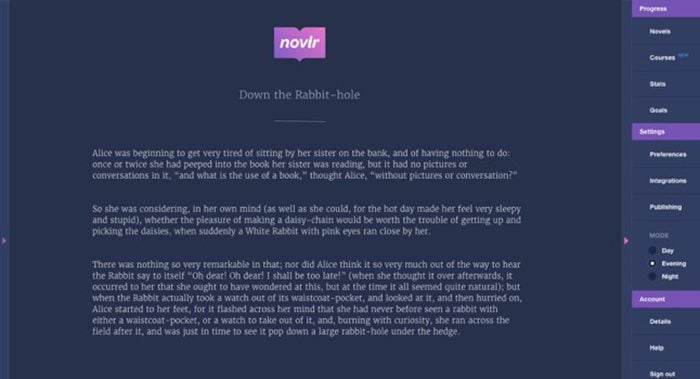
Novlr is a word processor built specifically for writing novels. It has a strong emphasis on grammar checking, cloud-based functionality, and ease of use. While not a contender as a book formatting tool, it works fine for a manuscript.
Who is it good for? Novlr is great for authors who want a simple, low-cost solution to both write and format a manuscript for an agent or editor.
4. OpenOffice
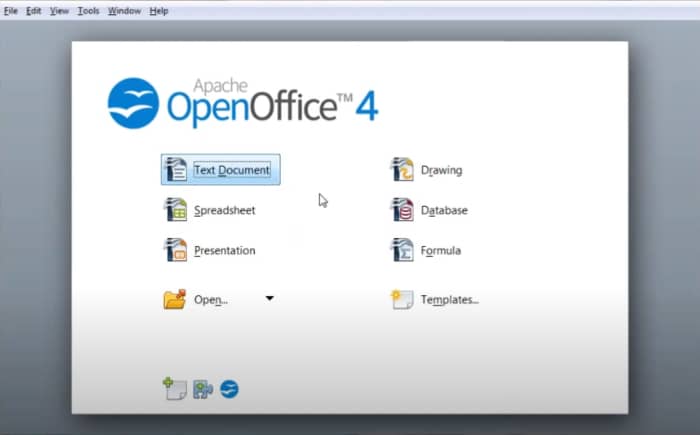
OpenOffice is an open-source alternative to Microsoft Word. And if you’re familiar with one, you’ll likely find the other easy to use. OpenOffice also has more functionality than Google Docs, and is better at working offline.
Who is it good for? OpenOffice is best for the author who cannot afford MS Word, and wants something with more functionality than a Google Doc. OpenOffice is both of these things.
5. Ulysses
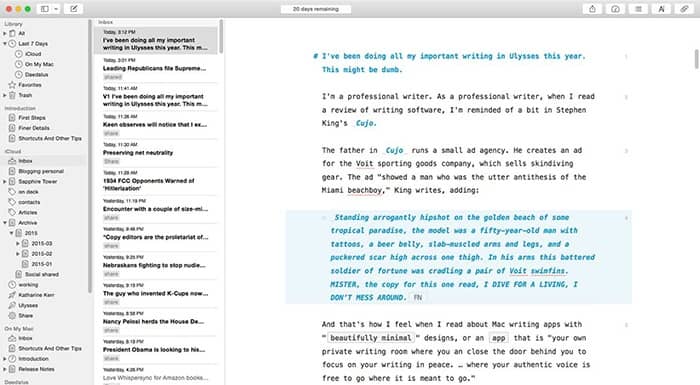
Ulysses brands itself as “The Ultimate Writing App for Mac, iPad, and iPhone”.
While only available on these platforms, it does offer powerful capabilities on mobile, something that other word processors haven’t yet mastered. Plus it offers a slew of features, including productivity and time management tools, as well cloud-based, multi-platform use.
Who is it good for? Ulysses is only available on Apple products. But authors who use Apple will find it perfect for their manuscript formatting needs.
5 Pro Tips That’ll Help You Format Your Book
Having the right software will get you nowhere if you don’t know how to format a book properly.
Because even with good software, if you indent your paragraphs wrong, or use a bad font, the end result will be jarring for readers.
To that end, here are five tips that you shouldn’t forget when formatting your book.
1. Don’t Skip the Title Page
When a reader opens a book, the title page is the first thing they see.
Therefore, you’ll want an impressive title page — one that informs the reader but also entices them to crack open your book.
What not to do: don’t just throw your book title and author name on a page and leave it be.
What to do: If you can, use an image of your book title that matches the text on the book cover. If not, use a large font size and style that matches the genre and a smaller font for subtitles and your author name.
2. Choose the Best Font
This doesn’t matter for eBooks, but for a printed book, you want to make sure you use a standard font, otherwise it will make it hard for the readers to follow.
What not to do: Use creative or unique fonts for the body of your text (however, creative and eye-catching fonts for chapter headings is okay).
What to do: Use a standard elegant font, with a size of 10-12. Example fonts include: Garamond, Arial, Times New Roman, Georgia, Verdana.
3. Watch for Widows and Orphans
Widows and orphans occur when a word exists by itself on one line, like so:
What not to do: Don’t leave the single word hanging or it will jar the reader.
What to do: Make slight adjustments in your margins, line height, spacing, etc. A good tool will avoid these completely, so consider investing in a quality formatting software.


4. Pick the Best Trim Size
The trim size is the actual dimensions of your book. Available trim sizes differ dramatically, so how do you know which is best?
What not to do: Don’t pick trim size without research first.
What to do: Look at the genre that matches your book and see what sizes are most common for that genre. The most common trim sizes are 5 x 8”, 5.5 x 8.5”, and 6 x 9” for fiction and non-fiction, but children’s books and the like may require other sizes.
5. Use Single Spacing
Back when authors wrote with typewriters, it was a common best practice to use a double space between sentences.
However, in the digital age, that rule is no longer valid.
What not to do: Don’t use double spacing. Ever.
What to do: If double spacing is a habit for you, retrain yourself to use one space after each sentence.
5 Tips to Follow When Formatting Your Manuscript
As with the recommended tools above, formatting a manuscript is different from formatting a book.
For the novel manuscript, your main concern is fitting it to a standard format that editors are accustomed to seeing.
Let’s take a look at some formatting options that you should not ignore.
1. Use Times New Roman
While it will vary from one publisher to another, Times New Roman is still the top-recommended font for most publishers.
What not to do: Don’t use extravagant font styles to gain attention.
What to do: Use Times New Roman or whatever recommended font the editor/agent prescribes.
2. Keep 1-inch Margins
Margins are critical for editors when they see a manuscript.
The space gives them plenty of room to take notes and make comments if they need to. The same goes for double spacing, which is another common recommendation. On the flip side, margins that are too large take up too much space.
What not to do: Don’t use 0.5” fonts, or anything larger than 1”
What to do: Use 1” margins or whatever the editor/agent personally recommends.
3. Understand Indents
Most word processors automatically create a new paragraph when you hit enter. And if you’ve styled your document correctly, there’s no need to use the TAB key to indent your paragraph. However, many of us still use it often.
What not to do: Don’t create an extra-large indent over 0.5”.
What to do: Keep the indent to no more than 0.5”. If you use TAB regularly, go to your word processor settings to turn off the automatic indent. FYI: I recommend training yourself not to use TAB.
4. Use Page Breaks
It’s a natural instinct when you reach the end of a chapter to keep hitting the Return/Enter key until a new page starts. But the Page Break function is built for just these circumstances.
What not to do: Don’t keep hitting Return/Enter until your new chapter is on a new page.
What to do: Use the Page Break function available in most — if not all — word processors.
5. Export to Word
If you are sending your manuscript in a digital format to an editor or agent, you’ll want to make sure it’s in a format they can recognize. For most people, the universally accepted file type is .DOCX for Microsoft Word.
What not to do: Don’t send a file type unique to Google Docs, Scrivener, OpenOffice, or any other word processor.
What to do: Most word processors will export to a .DOCX, so do this when your manuscript is ready.
The Bottom Line on How to Format a Book
So, what is the big takeaway here?
Well, my biggest recommendation is that you simply do not skimp out on book formatting.
Even if you have million-dollar writing packed with powerful words and stunning sensory details, without proper formatting, your book might end up being a hot mess. So, take the time to get it right.
For tools, most authors will appreciate Atticus, Vellum, or Kindle Create to produce quality books. And Microsoft Word is the gold standard when it comes to manuscript formatting.
When you get your book’s format right, it looks great, and readers will notice.
Ultimately, you will find that spending the time/money on good formatting will pay itself back.
The post How to Format a Book: 12 Tools & 10 Tips (+ LOTS of Free Info) appeared first on Smart Blogger.


No comments:
Post a Comment